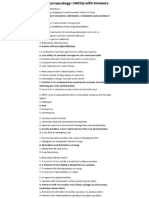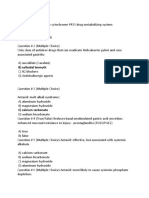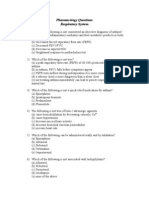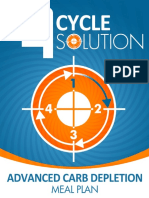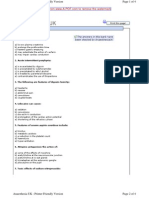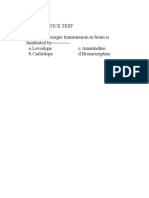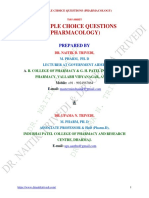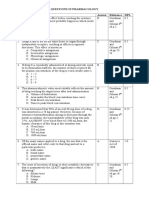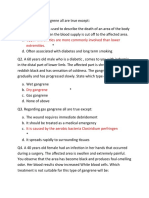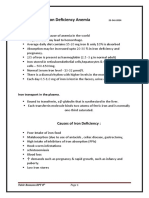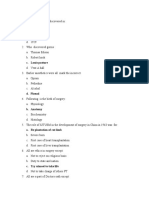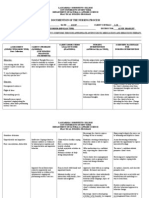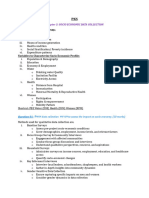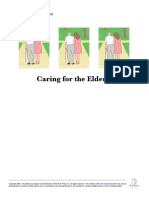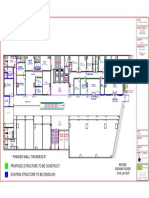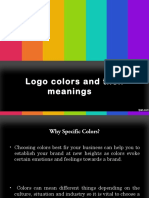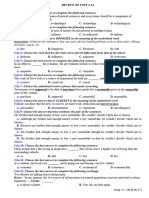0 ratings0% found this document useful (0 votes)
1K viewsPART I Drugs Acting On Respiratory System 2
PART I Drugs Acting On Respiratory System 2
Uploaded by
arbazThis document contains questions about drugs that act on the respiratory system and synthetic antibacterial drugs. It asks about mechanisms of action, indications, side effects, and classifications of various drugs including bronchodilators, expectorants, antitussives, antimycobacterial drugs, sulfonamides, metronidazole, nitrofurans, and fluoroquinolones. The questions are multiple choice format with one correct answer out of 4 options for each question.
Copyright:
© All Rights Reserved
Available Formats
Download as DOC, PDF, TXT or read online from Scribd
PART I Drugs Acting On Respiratory System 2
PART I Drugs Acting On Respiratory System 2
Uploaded by
arbaz0 ratings0% found this document useful (0 votes)
1K views9 pagesThis document contains questions about drugs that act on the respiratory system and synthetic antibacterial drugs. It asks about mechanisms of action, indications, side effects, and classifications of various drugs including bronchodilators, expectorants, antitussives, antimycobacterial drugs, sulfonamides, metronidazole, nitrofurans, and fluoroquinolones. The questions are multiple choice format with one correct answer out of 4 options for each question.
Original Description:
arbaz
Original Title
PART I Drugs Acting on Respiratory System 2
Copyright
© © All Rights Reserved
Available Formats
DOC, PDF, TXT or read online from Scribd
Share this document
Did you find this document useful?
Is this content inappropriate?
This document contains questions about drugs that act on the respiratory system and synthetic antibacterial drugs. It asks about mechanisms of action, indications, side effects, and classifications of various drugs including bronchodilators, expectorants, antitussives, antimycobacterial drugs, sulfonamides, metronidazole, nitrofurans, and fluoroquinolones. The questions are multiple choice format with one correct answer out of 4 options for each question.
Copyright:
© All Rights Reserved
Available Formats
Download as DOC, PDF, TXT or read online from Scribd
Download as doc, pdf, or txt
0 ratings0% found this document useful (0 votes)
1K views9 pagesPART I Drugs Acting On Respiratory System 2
PART I Drugs Acting On Respiratory System 2
Uploaded by
arbazThis document contains questions about drugs that act on the respiratory system and synthetic antibacterial drugs. It asks about mechanisms of action, indications, side effects, and classifications of various drugs including bronchodilators, expectorants, antitussives, antimycobacterial drugs, sulfonamides, metronidazole, nitrofurans, and fluoroquinolones. The questions are multiple choice format with one correct answer out of 4 options for each question.
Copyright:
© All Rights Reserved
Available Formats
Download as DOC, PDF, TXT or read online from Scribd
Download as doc, pdf, or txt
You are on page 1of 9
PART I Drugs acting on respiratory system
001. Following drugs directly activate the respiratory center
EXCEPT:
a) Bemegride
b) Caffeine
c) Aethymizole
d) Cytiton
002. The mechanism of Cytiton action is:
a) Direct activation of the respiratory center
b) The reflex mechanism
c) The mixed mechanism
d) None of the above
003. Indicate the drug belonging to antitussives of narcotic type of
action:
a) Glaucine hydrochloride
b) Aethylmorphine hydrochloride
c) Tusuprex
d) Libexine
004. Tick out the drug belonging to non-narcotic antitussives:
a) Libexine
b) Tusuprex
c) Codeine
d) Aethylmorphine hydrochloride
005. Indicate the expectorant with the reflex mechanism:
a) Sodium benzoate
b) Derivatives of Ipecacucnha and Thermopsis
c) Trypsin
d) Ambroxol
006. Tick the antitussive agent with a peripheral effect:
a) Codeine
b) Tusuprex
c) Libexine
d) Glaucine hydrochloride
007. Chymotrypsin is an agent containing free sulfhydryl groups.
It’s:
a) True
b) False
008. All of these drugs contain free sulfhydryl groups EXCEPT:
a) Acetylcysteine
b) Ambroxol
c) Bromhexin
d) Trypsin
009. Which of the following drugs is proteolytic enzyme?
a) Potassium iodide
b) Desoxiribonuclease
c) Carbocysteine
69
d) Acetylcysteine
010. All of the following drugs destroy disulfide bonds of
proteoglycans, which causes depolymerization and reduction of
viscosity of sputum, EXCEPT:
a) Acetylcysteine
b) Ambroxol
c) Desoxiribonuclease
d) Bromhexin
011. Which of these groups of drugs is used for asthma treatment?
a) Methylxanthines
b) M-cholinoblocking agents
c) Beta2 - stimulants
d) All of above
012. Tick the drug belonging to non-selective beta2-adrenomimics:
a) Salbutamol
b) Isoprenaline
c) Salmeterol
d) Terbutaline
013. Select the side-effect characteristic for non-selective beta2-
adrenomimics:
a) Depression of the breathing centre
b) Tachycardia
c) Peripheral vasoconstriction
d) Dry mouth
014. Pick out the bronchodilator drug related to xanthine:
a) Atropine
b) Orciprenaline
c) Adrenaline
d) Theophylline
015. Pick out the bronchodilator drug belonging to
sympathomimics:
a) Isoprenaline
b) Ephedrine
c) Atropine
d) Salbutamol
016. The property of prolonged theophyllines is the prevention of
night asthmatic attacks. It’s:
a) True
b) False
017. The mechanism of methylxanthines action is:
a) Inhibition of the enzyme phosphodiesterase
b) Beta2 -adrenoreceptor stimulation
c) Inhibition of the production of inflammatory cytokines
d) Inhibition of M-cholinoreceptors
018. Which of the following M-cholinoblocking agents is used
especially as an anti-asthmatic?
a) Atropine
b) Ipratropium
c) Platiphylline
d) Metacin
019. Indicate the side effect of Theophylline:
a) Bradycardia
b) Increased myocardial demands for oxygen
c) Depression of respiratory centre
d) Elevation of the arterial blood pressure
020. All of the following drugs are inhaled glucocorticoids EXCEPT:
a) Triamcinolone
b) Beclometazone
c) Sodium cromoglycate
d) Budesonide
021. Choose the drug belonging to membranestabilizing agents:
a) Zileutin
b) Sodium cromoglycate
c) Zafirlucast
d) Montelucast
022. Tick the drug which is a 5-lipoxygenase inhibitor:
70
a) Budesonide
b) Sodium cromoglycate
c) Zileutin
d) Beclometazone
023. Zileutin prevents the production of leukotrienes. This
statement is:
a) True
b) False
024. Indicate the drug which is a leucotriene receptor antagonist:
a) Sodium cromoglycate
b) Zafirlucast
c) Zileutin
d) Triamcinolone
025. Zafirlucast prevents aspirin-sensitive asthma. This
consideration is:
a) True
b) False
PART II SYNTHETIC ANTIBACTERIAL DRUGS
001. Sulfonamides are effective against:
a) Bacteria and Chlamidia
b) Actinomyces
c) Protozoa
d) All of the above
002. Mechanism of sulfonamides’ antibacterial effect is:
a) Inhibition of dihydropteroate reductase
b) Inhibition of dihydropteroate synthase
c) Inhibition of cyclooxygenase
d) Activation of DNA gyrase
003. Combination of sulfonamides with trimethoprim:
a) Decreases the unwanted effects of sulfonamides
b) Increases the antimicrobial activity
c) Decreases the antimicrobial activity
d) Increases the elimination of sulfonamides
004. Sulfonamide potency is decreased in case of co-
administration with:
a) Oral hypoglycemic agents
b) Local anesthetics – derivatives of paraaminobenzoic
acid
c) Local anesthetics – derivatives of benzoic acid
d) Non-narcotic analgesics
005. The following measures are necessary for prevention of
sulfonamide precipitation and crystalluria:
a) Taking of drinks with acid pH
b) Taking of drinks with alkaline pH
c) Taking of saline drinks
d) Restriction of drinking
006. Resorptive sulfonamides have the following unwanted effects
on blood system:
a) Hemolytic anemia
b) Thrombocytopenia
c) Granulocytopenia
d) All of the above
007. Mechanism of Trimethoprim’ action is:
a) Inhibition of cyclooxygenase
b) Inhibition of dihydropteroate reductase
c) Inhibition of dihydropteroate synthase
d) Inhibition of DNA gyrase
008. Sulfonamides have the following unwanted effects:
a) Hematopoietic disturbances
b) Crystalluria
c) Nausea, vomiting and diarrhea
d) All of the above
009. Tick the drug, which is effective against mycobacteria only:
a) Isoniazid
b) Streptomycin
c) Rifampin
130
d) Kanamycin
010. Tick the antimycobacterial drug belonging to first-line agents:
a) PAS
b) Isoniazid
c) Kanamycin
d) Pyrazinamide
011. Tick the antimycobacterial drug, belonging to second-line
agents:
a) Isoniazid
b) PAS
c) Rifampin
d) Streptomycin
012. Tick the antimycobacterial drug, belonging to antibiotics:
a) Isoniazid
b) PAS
c) Ethambutol
d) Rifampin
013. Tick the antimycobacterial drug – hydrazide of isonicotinic
acid:
a) Rifampin
b) Isoniazid
c) Ethambutol
d) Pyrazinamide
014. Mechanism of Izoniazid action is:
a) Inhibition of protein synthesis
b) Inhibition of mycolic acids synthesis
c) Inhibition of RNA synthesis
d) Inhibition of ADP synthesis
015. Mechanism of Rifampin action is:
a) Inhibition of mycolic acids synthesis
b) Inhibition of DNA dependent RNA polymerase
c) Inhibition of topoisomerase II
d) Inhibition of cAMP synthesis
016. Mechanism of Cycloserine action is:
a) Inhibition of mycolic acids synthesis
b) Inhibition of RNA synthesis
c) Inhibition of cell wall synthesis
d) Inhibition of pyridoxalphosphate synthesis
017. Mechanism of Streptomycin action is:
a) Inhibition of cell wall synthesis
b) Inhibition of protein synthesis
c) Inhibition of RNA and DNA synthesis
d) Inhibition of cell membranes permeability
018. Rifampin has the following unwanted effect:
a) Dizziness, headache
b) Loss of hair
c) Flu-like syndrome, tubular necrosis
d) Hepatotoxicity
019. Isoniazid has following unwanted effect:
a) Cardiotoxicity
b) Hepatotoxicity, peripheral neuropathy
c) Loss of hair
d) Immunotoxicity
020. Ethambutol has the following unwanted effect:
a) Cardiotoxicity
b) Immunetoxicity
c) Retrobulbar neuritis with red-green color blindness
d) Hepatotoxicity
021. Streptomycin has the following unwanted effect:
a) Cardiotoxicity
b) Hepatotoxicity
c) Retrobulbar neuritis with red-green color blindness
d) Ototoxicity, nephrotoxicity
131
022. Mechanism of aminosalicylic acid action is:
a) Inhibition of mycolic acids synthesis
b) Inhibition of folate synthesis
c) Inhibition of DNA dependent RNA polymerase
d) Inhibition of DNA gyrase
023. All of the following agents are the first-line antimycobacterial
drugs, EXCEPT:
a) Rifampin
b) Pyrazinamide
c) Isoniazid
d) Streptomycin
024. All of the following antimycobacterial drugs have a
bactericidal effect, EXCEPT:
a) Pyrazinamide
b) Streptomycin
c) Rifampin
d) Isoniazid
025. Combined chemotherapy of tuberculosis is used to:
a) Decrease mycobacterium drug-resistance
b) Increase mycobacterium drug-resistance
c) Decrease the antimicrobal activity
d) Decrease the onset of antimycobacterial drugs
biotransformation:
026. Tick the antibacterial drug – a nitrofurane derivative:
a) Nitrofurantoin
b) Trimethoprim
c) Ciprofloxacin
d) Nystatin
027. Tick the antibacterial drug – a nitroimidazole derivative:
a) Clavulanic acid
b) Metronidazole
c) Nitrofurantoin
d) Doxycycline
028. Tick the antibacterial drug – a quinolone derivative:
a) Nitrofurantoin
b) Nalidixic acid
c) Streptomycin
d) Metronidazole
029. Tick the antibacterial drug – a fluoroquinolone derivative:
a) Chloramphenicol
b) Nitrofurantoin
c) Nalidixic acid
d) Ciprofloxacin
030. Tick the indications for nitrofuranes:
a) Infections of respiratory tract
b) Infections of urinary and gastro-intestinal tracts
c) Syphilis
d) Tuberculosis
031. Tick the unwanted effects of nitrofuranes:
a) Nausea, vomiting
b) Allergic reactions
c) Hemolytic anemia
d) All of the above
032. Tick the indications for Metronidazole:
a) Intra-abdominal infections, vaginitis, enterocolitis
b) Pneumonia
c) As a disinfectant
d) Influenza
033. Tick the unwanted effects of Metronidazole:
a) Nausea, vomiting, diarrhea, stomatitis
b) Hypertension
c) Disturbances of peripheral blood circulation
d) All of the above
034. The mechanism of fluoroquinolones’ action is:
132
a) Inhibition of phospholipase C
b) Inhibition of DNA gyrase
c) Inhibition of bacterial cell synthesis
d) Alteration of cell membrane permeability
035. Fluoroquinolones are active against:
a) Gram negative microorganisms only
b) Mycoplasmas and Chlamidiae only
c) Gram positive microorganisms only
d) Variety of Gram-negative and positive microorganisms,
including Mycoplasmas and Chlamidiae
036. Tick the unwanted effects of fluoroquinolones:
a) Hallucinations
b) Headache, dizziness, insomnia
c) Hypertension
d) Immunetoxicity
037. Tick the indications for fluoroquinolones:
a) Infections of the urinary tract
b) Bacterial diarrhea
c) Infections of the urinary and respiratory tract, bacterial
diarrhea
d) Respiratory tract infections
038. The drug of choice for syphilis treatment is:
a) Gentamycin
b) Penicillin
c) Chloramphenicol
d) Doxycycline
You might also like
- MCQ Pract Pharma 1Document9 pagesMCQ Pract Pharma 1Syamil AzharNo ratings yet
- Pharmacology MCQS WITH ANS (1) - CompressedDocument289 pagesPharmacology MCQS WITH ANS (1) - Compressed09Dhawal Patil100% (1)
- MCQs of Pharmacology Unit-2 (D) Anti-Viral DrugsDocument4 pagesMCQs of Pharmacology Unit-2 (D) Anti-Viral DrugsShayan Shayan0% (1)
- Pharmacology 130 McqsDocument19 pagesPharmacology 130 McqsCornilius Khokher100% (2)
- Npte Exam TablesDocument586 pagesNpte Exam TablesarbazNo ratings yet
- 10-11 - Anti-Hyperlipidemic Drugs (Summary SAQ and MCQS)Document6 pages10-11 - Anti-Hyperlipidemic Drugs (Summary SAQ and MCQS)Purvak Mahajan100% (2)
- CVS MCQsDocument36 pagesCVS MCQssk100% (2)
- PHARMACOKINETICS MCQDocument10 pagesPHARMACOKINETICS MCQyan219100% (4)
- Git MCQDocument27 pagesGit MCQPadmavathi C100% (8)
- MCQ Base For Final Exam PreparationDocument131 pagesMCQ Base For Final Exam PreparationPurwa Rane100% (1)
- MCQ NsaidDocument1 pageMCQ NsaidMickey Brown94% (16)
- Pharmacology Questions RespiratoryDocument5 pagesPharmacology Questions Respiratoryasmakhadder87% (45)
- B. Stationary Attachment Flexible Endoskeleton: All of The AboveDocument9 pagesB. Stationary Attachment Flexible Endoskeleton: All of The AbovearbazNo ratings yet
- Special TestsDocument17 pagesSpecial Testsarbaz100% (1)
- 4 CYCLE FAT LOSS - Week 1 - Advanced Carb Depletion PDFDocument17 pages4 CYCLE FAT LOSS - Week 1 - Advanced Carb Depletion PDFDanCurtis100% (1)
- Multiple Choice QuestionsDocument15 pagesMultiple Choice QuestionsBayuaji JulianiNo ratings yet
- ANS, CNS KeyDocument8 pagesANS, CNS KeyUrugonda VenumadhavNo ratings yet
- Pharmacology MCQsDocument18 pagesPharmacology MCQsjerry garcia50% (2)
- Pharmacology - MCQsDocument28 pagesPharmacology - MCQsleenaloveu100% (4)
- Antiemetic Drug Questions BankDocument3 pagesAntiemetic Drug Questions Bankesraa elbassuonyNo ratings yet
- Unit#01 Pharma II MCqs Provided by MirhaDocument6 pagesUnit#01 Pharma II MCqs Provided by MirhaShayan Shayan100% (5)
- MCQS ANS 03 Sol PDFDocument4 pagesMCQS ANS 03 Sol PDFSamir Rekha Mukund Joshi100% (1)
- Pharma McqsDocument45 pagesPharma McqsFarah IqbalNo ratings yet
- MCQS ANS 01 Sol-1Document5 pagesMCQS ANS 01 Sol-1Samir Rekha Mukund JoshiNo ratings yet
- Cholinergic Drugs Quiz 16 - 20Document8 pagesCholinergic Drugs Quiz 16 - 20Killer VNo ratings yet
- Pharmacology of GITDocument29 pagesPharmacology of GITMohammed Bahnasy100% (2)
- MCQs - CRF & BalanceDocument2 pagesMCQs - CRF & BalanceSara RezaNo ratings yet
- Итоговое 2020 MCQDocument62 pagesИтоговое 2020 MCQmohammad farooque razaa100% (4)
- University of Hargeisa GIT Pharmacology Review Questions: Name:aniisa Muse Ahmed Faculty:midwifery ID:1716642 Class:3ADocument4 pagesUniversity of Hargeisa GIT Pharmacology Review Questions: Name:aniisa Muse Ahmed Faculty:midwifery ID:1716642 Class:3AAniza Mouse100% (1)
- Pharmacology MCQs 2Document6 pagesPharmacology MCQs 2Waseem SarwarNo ratings yet
- Pharmacology MCQsDocument47 pagesPharmacology MCQsIbne Hameed100% (3)
- MCQ CNS Practice TestDocument39 pagesMCQ CNS Practice TestUma Bhosale75% (4)
- MCQ 1 General Introduction and PharmacokineticsDocument7 pagesMCQ 1 General Introduction and PharmacokineticsVarmaNo ratings yet
- Antiarrhythmic Drugs-Test-1-QuestionsDocument7 pagesAntiarrhythmic Drugs-Test-1-QuestionsDrishya Bioplannet100% (2)
- MCQ Anti Hypertensive DrugDocument3 pagesMCQ Anti Hypertensive DrugPushpesh Chandra100% (1)
- 2001 Pharmacology McqsDocument10 pages2001 Pharmacology McqsKenneth MiguelNo ratings yet
- MCQS Zero and First Order KineticsDocument3 pagesMCQS Zero and First Order KineticsDr Zeemal100% (1)
- MCQ 1Document9 pagesMCQ 1Hasan MohamedNo ratings yet
- Cology Final McqsDocument33 pagesCology Final McqsSameer AliNo ratings yet
- (Cholinergic System) Model Questions and AnswersDocument45 pages(Cholinergic System) Model Questions and AnswersAjay SinghNo ratings yet
- Semester Iv Pharmacology I (BP404 TP) Multiple Choice Questions Chapter 1 & 2Document34 pagesSemester Iv Pharmacology I (BP404 TP) Multiple Choice Questions Chapter 1 & 2Aman Gurjar100% (1)
- Dr. Naitik D Trivedi & Dr. Upama N. Trivedi: Multiple Choice Questions (Pharmacology)Document65 pagesDr. Naitik D Trivedi & Dr. Upama N. Trivedi: Multiple Choice Questions (Pharmacology)Lokesh Mahata100% (1)
- Pharmacokinetics / Pharmacodynamics Mcqs May 2006Document36 pagesPharmacokinetics / Pharmacodynamics Mcqs May 2006Mishu100% (1)
- MCQ in PharmacologyDocument3 pagesMCQ in PharmacologySwaroopSinghJakhar100% (1)
- MCQs in PharmacologyDocument7 pagesMCQs in Pharmacologysidharta_chatterjee100% (1)
- B.Pharmacy-6 Semester (New PCI Syllabus) : Toxicology and ChronopharmacologyDocument4 pagesB.Pharmacy-6 Semester (New PCI Syllabus) : Toxicology and ChronopharmacologySaurabh Kumar RawatNo ratings yet
- CNS Pharmacology: Sedatives & HypnoticsDocument5 pagesCNS Pharmacology: Sedatives & HypnoticsMickey Brown86% (7)
- Unit 03 Pharmacology With AnswersDocument3 pagesUnit 03 Pharmacology With Answerssadia parveen100% (1)
- Summary & Mcqs of Adrenal Gland: Done byDocument7 pagesSummary & Mcqs of Adrenal Gland: Done byHabib Ullah100% (4)
- Pharmacology Solved 2Document2 pagesPharmacology Solved 2Thoby Mlelwa100% (1)
- Sparsh Gupta 14e-Anti Diabetes MCQDocument12 pagesSparsh Gupta 14e-Anti Diabetes MCQSubodh Chaudhari100% (2)
- MCQS On Local Anesthetics, DiureticsDocument18 pagesMCQS On Local Anesthetics, DiureticsShweta Yadav100% (1)
- NSAID's QuestionsDocument3 pagesNSAID's QuestionsManikanta Guptha100% (5)
- 1000 MCQS - PHARMACOLOGY Plus September 2014 MCQsDocument6 pages1000 MCQS - PHARMACOLOGY Plus September 2014 MCQsHarjotBrarNo ratings yet
- Pharma MCQ SDocument13 pagesPharma MCQ SKaye HernandezNo ratings yet
- Pharm Cns McqsDocument9 pagesPharm Cns McqsMohamed YousefNo ratings yet
- Antibiotic Revision: C. Co-TrimoxazoleDocument6 pagesAntibiotic Revision: C. Co-TrimoxazoleYoussef Radwan100% (1)
- MCQ Base Clinical Pharmacology PDFDocument30 pagesMCQ Base Clinical Pharmacology PDFTesfa HopeNo ratings yet
- CNS McqsDocument54 pagesCNS McqsMohammed KhalidNo ratings yet
- FINAL MATERIAL - TEST BANKDocument31 pagesFINAL MATERIAL - TEST BANKRayonesh RayanaNo ratings yet
- AntiprotozoalDocument9 pagesAntiprotozoalmwahalendejofreyNo ratings yet
- PART I Hypothalamic & Pituitary Hormones, Thyroid & Antithyroid DrugsDocument18 pagesPART I Hypothalamic & Pituitary Hormones, Thyroid & Antithyroid DrugsRinaFitria100% (1)
- AntibioticsDocument14 pagesAntibioticsSajin Sabu ManaloorNo ratings yet
- Antibiotics (Ahmed Shakir)Document16 pagesAntibiotics (Ahmed Shakir)Nashat SaadiNo ratings yet
- Furunculosis (Boils) & Carbuncles: Essentials of DiagnosisDocument10 pagesFurunculosis (Boils) & Carbuncles: Essentials of DiagnosisarbazNo ratings yet
- Eid by Alamgir HashmiDocument21 pagesEid by Alamgir Hashmiarbaz100% (2)
- Upper Extremities Are More Commonly Involved Than Lower ExtremitiesDocument27 pagesUpper Extremities Are More Commonly Involved Than Lower ExtremitiesarbazNo ratings yet
- Tradition and Individual Talent: Thomas Stern Eliot 1888-1965Document18 pagesTradition and Individual Talent: Thomas Stern Eliot 1888-1965arbazNo ratings yet
- Speaking Physiotherapy Sample Test 2Document1 pageSpeaking Physiotherapy Sample Test 2arbazNo ratings yet
- Charles Lamb: Irony and Wit Is The Common Subject of His Essays. Nineteenth CenturyDocument2 pagesCharles Lamb: Irony and Wit Is The Common Subject of His Essays. Nineteenth Centuryarbaz100% (1)
- Compiled McqsDocument24 pagesCompiled Mcqsarbaz100% (1)
- Iron Deficiency Anemia: Iron Transport in The PlasmaDocument13 pagesIron Deficiency Anemia: Iron Transport in The PlasmaarbazNo ratings yet
- Surgery 8th Semester McqsDocument24 pagesSurgery 8th Semester Mcqsarbaz0% (1)
- ABG Webinar March 2018Document51 pagesABG Webinar March 2018arbazNo ratings yet
- Lec 1 Gangrene: C. Upper Extremities Are More Commonly Involved Than Lower ExtremitiesDocument13 pagesLec 1 Gangrene: C. Upper Extremities Are More Commonly Involved Than Lower ExtremitiesarbazNo ratings yet
- Implications For Secretion ClearanceDocument27 pagesImplications For Secretion ClearancearbazNo ratings yet
- DPT MCQS HaematologyDocument6 pagesDPT MCQS Haematologyarbaz0% (1)
- MCQ's B.A Third Year (Semester) Economics Paper 113Document12 pagesMCQ's B.A Third Year (Semester) Economics Paper 113arbazNo ratings yet
- Nutrition MCQs MJJKDocument14 pagesNutrition MCQs MJJKarbazNo ratings yet
- A. 10th Anterior Rib B. C. 7th Anterior Rib D. 8th Anterior Rib E. 8th Posterior RibDocument12 pagesA. 10th Anterior Rib B. C. 7th Anterior Rib D. 8th Anterior Rib E. 8th Posterior RibarbazNo ratings yet
- Chapter 2 Mcqs - Kinematic Concept AnsDocument8 pagesChapter 2 Mcqs - Kinematic Concept AnsarbazNo ratings yet
- Ao ADocument6 pagesAo AarbazNo ratings yet
- D. A Systematic Process of Gathering, Analyzing and Interpreting DataDocument8 pagesD. A Systematic Process of Gathering, Analyzing and Interpreting DataarbazNo ratings yet
- THR Rehab Practice Guidelines-Updated 23mar2011Document2 pagesTHR Rehab Practice Guidelines-Updated 23mar2011arbazNo ratings yet
- TKR Rehab Practice Guidelines-Updated 23mar2011Document2 pagesTKR Rehab Practice Guidelines-Updated 23mar2011arbazNo ratings yet
- Mushroom Poisoning More Than Identification Benjamin Cikke 2019Document4 pagesMushroom Poisoning More Than Identification Benjamin Cikke 2019Gábor JancsóNo ratings yet
- Guidance FSMA LACF 12102021Document10 pagesGuidance FSMA LACF 12102021william eduardo mercado navarroNo ratings yet
- Care Plan For Schizoaffective DisorderDocument2 pagesCare Plan For Schizoaffective DisorderThalia Peart100% (13)
- Notes PKSDocument12 pagesNotes PKSAshraf ZamanNo ratings yet
- Brgy Health PlanDocument17 pagesBrgy Health Planlraczerimar1984No ratings yet
- Clup-San-Fernando-Sectoral Studies-Volume-3Document314 pagesClup-San-Fernando-Sectoral Studies-Volume-3Jerome BasNo ratings yet
- Meditex BrochureDocument4 pagesMeditex BrochureVishwesh SubsNo ratings yet
- Physical and Personal Development in The Arts: Quarter 1 The Anatomy of An ArtistDocument14 pagesPhysical and Personal Development in The Arts: Quarter 1 The Anatomy of An ArtistCarl Benedict RevillaNo ratings yet
- DR Michael Usi CV 2020Document3 pagesDR Michael Usi CV 2020mosesmwikoma1No ratings yet
- Compilation Injury UPDATEDDocument78 pagesCompilation Injury UPDATEDAhmad HaziqNo ratings yet
- Soal Ulangan Materi LabelDocument5 pagesSoal Ulangan Materi Labelsitti rahayu armita lestariNo ratings yet
- Mekonnen Gizachew PDFDocument60 pagesMekonnen Gizachew PDFkelid IbrahimNo ratings yet
- Homework 1 6Document6 pagesHomework 1 6uht1103No ratings yet
- Revised Civil DWG For Ground Floor 17.9.21Document1 pageRevised Civil DWG For Ground Floor 17.9.21Nitesh PatilNo ratings yet
- Changes To ISO14001 and OHSAS18001-IsO45001 - HandoutDocument6 pagesChanges To ISO14001 and OHSAS18001-IsO45001 - HandoutDhananjay PatilNo ratings yet
- The Objectives of Physical EducationDocument8 pagesThe Objectives of Physical EducationdaisyrieewrightsNo ratings yet
- Logo Colors and Their MeaningsDocument15 pagesLogo Colors and Their MeaningsYeremia Alfa AdimurtiNo ratings yet
- Osteoma NepalDocument5 pagesOsteoma NepalRafael Lemos de SouzaNo ratings yet
- NG and Learning Behavioral Objectives and Teaching PlanDocument18 pagesNG and Learning Behavioral Objectives and Teaching PlanMaria Kathleen ArrofoNo ratings yet
- Recommendation FormsDocument1 pageRecommendation FormsRezi Sabutanan AmerilaNo ratings yet
- Literature ReviewDocument4 pagesLiterature Reviewapi-582823402No ratings yet
- Balance GradesDocument4 pagesBalance GradesamoNo ratings yet
- Same Sex Marriage Debate SpeechDocument2 pagesSame Sex Marriage Debate SpeechJommelApatayCagoyongII100% (1)
- It's Never Just A Block An Analysis of Regional Anesthesia Closed Claims 2019Document9 pagesIt's Never Just A Block An Analysis of Regional Anesthesia Closed Claims 2019Fransisca Dewi KumalaNo ratings yet
- Sager 1990Document12 pagesSager 1990sumitha ganesanNo ratings yet
- Impact of Using Non-Rebreathing Mask in Patients With Respiratory FailureDocument17 pagesImpact of Using Non-Rebreathing Mask in Patients With Respiratory Failureedsel ligiantaNo ratings yet
- How To Stop Being ParanoidDocument10 pagesHow To Stop Being ParanoidCharmaine AlipayoNo ratings yet
- Review of Unit 1Document4 pagesReview of Unit 1Thai LangNo ratings yet
- Point 70Document42 pagesPoint 70cyrus ian lanuriasNo ratings yet

